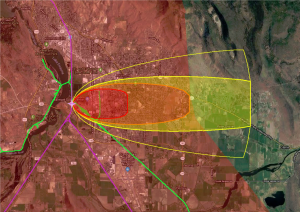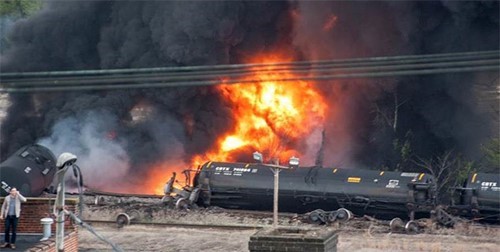Derailment in Lynchburg, VA on April 30, 2014. Train carried crude oil.
Shipping commodities by rail is an extremely cost-effective means of transportation compared with trucking. Additionally, shipping commodities by rail has proven to be safer than shipping by truck. The Bureau of Transportation Statistics (BTS) states that there were 15,289 highway incidents in 2017. Despite the safety and security systems in place, there were still 471 derailments resulting in releases of Hazardous Materials (HazMat) in 2017, according to the BTS.

Alliance Solutions Group is currently working with counties across the U.S. to strengthen and improve HAZMAT rail incident response through planning, training and exercises. Before beginning the development of a plan, we recommend using quantitative methods to conduct a risk assessment. This allows those who are planning to focus their limited resources on the highest threats and hazards. The risk assessment is based on data from a rail transporter’s Commodity Density Report. Using the hazards listed in this report, we produce explosion and plume models and conduct analysis in GIS applications to determine vulnerable populations and infrastructure. Once we identify the hazards and assess the risks, we are able to understand the context for developing a plan and the information needed from relevant stakeholders.
Throughout the planning process we gather information related to impacts on people, the environments, businesses, emergency management infrastructure and equipment, among other items. This proven process helps determine capabilities, vulnerabilities and other risks. Each community or tribe is unique with respect to its capabilities, resources and relationships with external agencies that can support a response. But we have found that one of the most important elements of planning is the consequence analysis. If a potential consequence is neglected, it is probable that a key stakeholder will be left out of the planning process. To achieve effective plans, it is critical that planners engage the whole community of public sector, private industry, rail operators, citizens, businesses, faith-based organizations and volunteers. Additionally, consequence analysis enables effective pre-incident planning for decision makers such as the incident commander.
Evacuation and shelter-in-place (SIP) are two Public Protective Actions (PPAs) available to the incident commander when a hazardous material has been released. We employ several models that help evaluate the effectiveness of these options so that the incident response plan will contain some pre-emptive information for decision makers. Finally, emergency planners cannot possibly build a program that will address every risk at the highest magnitudes, but through risk-based planning, the emergency planner can set SMART goals to build capabilities. Upon completion of the analysis and planning, we utilize the Plans, Organization, Equipment, Training, Exercises (POETE) framework to make recommendations to further develop SMART goals and capabilities that are appropriate for the community. The POETE framework enables the development of activities that further strengthen and improve preparedness.
After developing and integrating the rail incident response plan into the community’s Emergency Operations Plan and Emergency Response Plan, it is beneficial to conduct training on the plans so that stakeholders understand each other’s roles and responsibilities as well as their own. This may start with a seminar and lead to a tabletop or full-scale exercise to validate the enhanced capability.
To learn more about how to develop and integrate a Rail Incident Response Plan into your community’s plans, contact Robert Campbell at Robert.campbell@asg-inc.org or call our office at (757) 223-7233 to discuss your planning, training and exercise needs.
Alliance Solutions Group, Inc. (ASG) has provided EHS and Emergency Management professional services to over 2,000 communities in 44 states, and 17 countries over the last 13 years. As an ISO-certified organization, we attain the highest quality in our products and services. With over a 97% customer return rate, customer satisfaction is a hallmark of our business. We partner with clients to prepare for a safe and secure tomorrow in their workplace, environment and community. Hundreds of plans developed, thousands of exercises conducted, and tens-of-thousands trained.
Don't worry, no spam here!
Keep up to date with the latest trends, best practices and innovations in the Emergency Management and Environmental, Health and Safety sectors.

